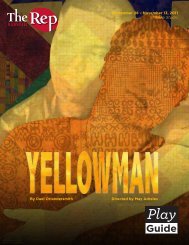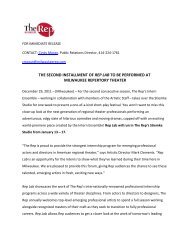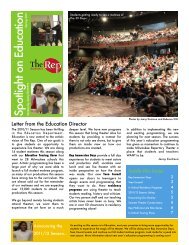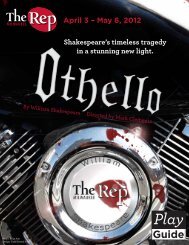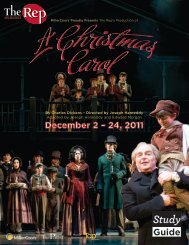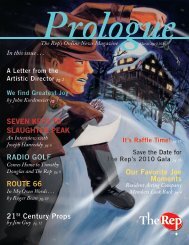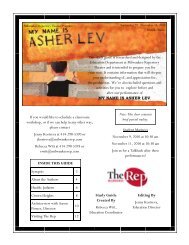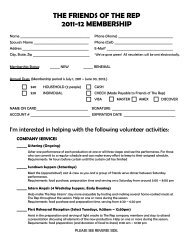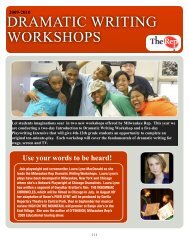Download/Print (.pdf) - Milwaukee Repertory Theater
Download/Print (.pdf) - Milwaukee Repertory Theater
Download/Print (.pdf) - Milwaukee Repertory Theater
You also want an ePaper? Increase the reach of your titles
YUMPU automatically turns print PDFs into web optimized ePapers that Google loves.
September 26 – November 4, 2012<br />
By Katori Hall<br />
Cover artwork by Oberlander Group
The Mountaintop<br />
STUDY GUIDE<br />
•<br />
<strong>Milwaukee</strong> <strong>Repertory</strong> <strong>Theater</strong><br />
presents<br />
Written by<br />
Leda Hoffmann<br />
Education Coordinator<br />
•<br />
Additional writing by<br />
Zachary Schley<br />
Education Intern<br />
By Katori Hall<br />
September 26 – November 4<br />
Stiemke Studio<br />
•<br />
Study Guide edited by<br />
Brent Hazelton<br />
Associate Artistic Director<br />
Jenny Kostreva<br />
Education Director<br />
Lisa Fulton<br />
Marketing Director<br />
•<br />
Graphic Design by<br />
Megan Gadient<br />
MARK’S TAKE:<br />
“The Mountaintop isn’t a biography,<br />
per se, but rather a very smart,<br />
very funny, very moving, and very<br />
respectful exploration of the ideas<br />
that were occupying Dr. King’s mind<br />
on the night prior to his death. The maid character<br />
is essential to this innately theatrical play, but<br />
impossible to describe without giving away a clever<br />
twist that the audience will absolutely lap up!”<br />
-Mark Clements, Artistic Director<br />
Tickets: 414-224-9490<br />
www.<strong>Milwaukee</strong>Rep.com<br />
Mark Clements<br />
Artistic Director<br />
Dawn Helsing Wolters<br />
Managing Director<br />
MILWAUKEE REPERTORY<br />
THEATER<br />
108 E. Wells Street<br />
<strong>Milwaukee</strong>, WI • 53202<br />
TABLE OF CONTENTS<br />
Page 3 Synopsis<br />
Page 4 Dr. Martin Luther King, Jr.<br />
Page 5 Katori Hall<br />
Page 6 The “Mountaintop” Speech<br />
Page 7 MLK Jr.’s Final Days<br />
Page 9 The Civil Rights Movement<br />
Page 11 Vocabulary<br />
Page 12 Visiting The Rep<br />
The Mountaintop Study Guide • pg 2
SYNOPSIS<br />
Well, I don’t know what will happen now.<br />
it really doesn’t matter with me now,<br />
because I’ve been to the mountaintop.<br />
And I don’t mind. Like anybody, I would<br />
like to live a long life. Longevity has its<br />
place. But I’m not concerned about that<br />
now. I just want to do God’s will. And He’s<br />
allowed me to go up to the mountain.<br />
And I’ve looked over. And I’ve seen the<br />
Promised Land. I may not get there with<br />
you. But I want you to know tonight, that<br />
we, as a people, will get to the promised<br />
land! And so I’m happy, tonight. I’m not<br />
worried about anything. I’m not fearing<br />
any man! Mine eyes have seen the glory<br />
of the coming of the Lord!<br />
– Dr. Martin Luther King, Jr.,<br />
“Mountaintop” Speech, April 3, 1968<br />
After his "I've Been to the Mountaintop" speech, Dr. Martin Luther King, Jr., retires to his<br />
room in the Lorraine Motel in Memphis, Tennessee. He is tired, overwrought, in need of<br />
clarity, and deeply questioning both the success of and his value to the Civil Rights movement.<br />
Camae, a beautiful young hotel maid, enters. She is as awed by Dr. King¹s fame as he is by her<br />
beauty. The chemistry between them sparks immediately, and Dr. King invites her to sit and<br />
talk for awhile. Their ensuing conversation, lasting throughout the long `night, covers topics<br />
both personal and political—from Dr. King's children, to the Memphis Sanitation Strike, to a<br />
debate about violent versus non-violent revolution.<br />
As the evening progresses, Camae grows more mysterious, revealing thoughts and events about<br />
which only Dr. King could know. As it becomes increasingly clear that Camae is more than just<br />
an ordinary maid, she leads Dr. King through a powerful, vivid exploration of his life and<br />
legacy on what would become his final night on earth.<br />
CHARACTERS<br />
KING<br />
The Reverend Dr. Martin<br />
Luther King, Jr.<br />
CAMAE<br />
A maid at the<br />
Lorraine Motel.<br />
www.<strong>Milwaukee</strong>Rep.com • pg 3
DR. MARTIN LUTHER KING, JR.<br />
Dr. Martin Luther King, Jr. led the American Civil Rights<br />
Movement from December, 1955, to April 4, 1968, preaching a<br />
philosophy of non-violent protest, grassroots organizing, and<br />
civil disobedience.<br />
Dr. King was born into a religious family. His grandfather<br />
and father were pastors of the Ebenezer Baptist Church in<br />
Atlanta, Georgia. Dr. King drew on his faith for his principles<br />
and spoke frequently about his duty to God.<br />
Dr. Martin Luther King, Jr., with his wife, Coretta and<br />
their first daughter, Yolanda.<br />
Dr. Martin Luther King, Jr.<br />
Dr. King attended segregated public schools in Georgia, and then<br />
attended Morehouse College, an African-American institution in Atlanta,<br />
from which both his father and grandfather had graduated. Dr. King then<br />
studied theology for three years at the Crozer Theological Seminary in<br />
Pennsylvania where he was elected president of a predominantly white<br />
senior class. He then enrolled in graduate studies at Boston University,<br />
completing his residence for the doctorate in 1953. In Boston, he met<br />
and married Coretta Scott, a young woman studying at the New England<br />
Conservatory of Music. They would have two sons and two daughters.<br />
By 1954, Dr. King was a member of the executive committee of the National Association for<br />
the Advancement of Colored People (NAACP), and the pastor of the Dexter Avenue Baptist<br />
Church in Montgomery, Alabama. When the Montgomery bus boycott began in 1955, Dr. King<br />
became one of the leaders of the movement.<br />
The Montgomery bus boycott became one of the most successful non-violent demonstrations<br />
in modern history. During the boycott, King was arrested and his home was bombed, but he<br />
emerged as a great leader of the non-violent civil rights movement. The boycott lasted 382<br />
days and ended with a Supreme Court decision declaring bus segregation unconstitutional.<br />
In 1957, Dr. King was elected president of the Southern Christian Leadership Conference (SCLC),<br />
formed to provide leadership for the growing civil rights movement. For the next eleven years,<br />
Dr. King travelled the country speaking over twenty-five hundred times, leading protests, and<br />
acting against injustice. He wrote “Letter from a Birmingham Jail,” a manifesto for the civil<br />
rights movement, following his arrest during a protest in Birmingham; he told over 250,000<br />
people “I Have a Dream” during a march in Washington, D.C.; and he led thousands in marches<br />
from Selma to Montgomery. At the age of thirty-five, Dr. King became the youngest person to<br />
win a Nobel Peace Prize. He gave the prize money to the Civil Rights Movement.<br />
In April of 1968, in Memphis, Tennessee, to support a sanitation workers strike, Dr. Martin<br />
Luther King, Jr., was assassinated. The news shook the nation. Dr. King remains a symbol<br />
of non-violence across the world and he is the only non-president to have a memorial on the<br />
National Mall in Washington, D.C.<br />
₪ For further resources on Dr. King go to www.<strong>Milwaukee</strong>Rep.com/season/mountaintop.html<br />
The Mountaintop Study Guide • pg 4
KATORI HALL<br />
Katori Hall is a playwright and performer from Memphis,<br />
Tennessee. Her work has been produced on Broadway, in<br />
London’s West End, and in regional theaters throughout<br />
the United States.<br />
As an African-American growing up in a predominately<br />
white neighborhood, Hall was very aware of racial issues and<br />
the legacy of the civil rights movement as a child. She was<br />
raised in a working-class household, the youngest of four<br />
Katori Hall<br />
daughters. In 2003, she graduated from Columbia University<br />
and continued her training at Harvard and Julliard.<br />
While training as an actor at Columbia, Hall felt a lack of roles for African-American women.<br />
At that moment, she knew she had to write. Today, Katori Hall’s published plays include The<br />
Mountaintop, Hoodoo Love, Hurt Village, and Saturday Night/Sunday Morning.<br />
The Mountaintop was inspired by Hall’s mother, Carrie Mae Golden. In 1968, Carrie Mae asked<br />
her mother if she could go to hear Dr. King speak at the Mason Temple. Her mother did not<br />
let her go because she feared that the church would be bombed. The female character in The<br />
Mountaintop, Camae (short for Carrie Mae), is named for Katori Hall’s mother, giving her the<br />
chance she never had to meet Dr. King.<br />
₪ For more on Katori Hall go to www.<strong>Milwaukee</strong>Rep.com/season/mountaintop.html<br />
Katori Hall<br />
www.<strong>Milwaukee</strong>Rep.com • pg 5
THE “MOUNTAINTOP” SPEECH<br />
Dr. Martin Luther King, Jr., gave his final speech at Mason Temple in Memphis,<br />
Tennessee, on April 3, 1968. He spoke to support a strike by sanitation workers, and<br />
expressed his vision for the future of civil rights. His comments about the end of his<br />
life seem to predict his own death. Below are some selected quotes from the speech.<br />
QUESTIONS<br />
Dr. King mentions<br />
death frequently in<br />
this speech. Was<br />
Dr. King predicting<br />
his own death the<br />
night before his<br />
assassination?<br />
Dr. King is<br />
remembered as a<br />
great public speaker.<br />
What rhetorical<br />
devices does he<br />
use in the speech<br />
to captivate the<br />
audience?<br />
From this speech,<br />
how does King<br />
imagine the future<br />
of the civil rights<br />
struggle?<br />
“Something is happening in our world. The masses of people are rising up. And<br />
wherever they are assembled today . . . – the cry is always the same:<br />
We want to be free.”<br />
“Somewhere I read of the freedom of assembly, somewhere I read of the freedom of<br />
speech, somewhere I read of the freedom of the press.<br />
Somewhere I read that the greatness of America<br />
is the right to protest for right.”<br />
“The question is not, “If I stop to help this man in need, what will happen to me? . . .<br />
The question is, if I do not stop to help the sanitation workers,<br />
what will happen to them? That’s the question.”<br />
“We’ve got some difficult days ahead. But it really doesn’t matter with me now,<br />
because I’ve been to the mountaintop . . . And I’ve looked over. And I’ve seen the<br />
Promised Land. I may not get there with you. But I want you to know tonight, that<br />
we, as a people, will get to the Promised Land! And so I’m happy, tonight.<br />
I’m not worried about anything. I’m not fearing any man!<br />
Mine eyes have seen the glory of the coming of the Lord!”<br />
₪ The full text of “The Mountaintop” speech can be found at<br />
www.americanrhetoric.com. For more on “The Mountaintop” speech visit<br />
www.<strong>Milwaukee</strong>Rep.com/season/mountaintop.html<br />
The Mountaintop Study Guide • pg 6
MARTIN LUTHER KING JR.’S FINAL DAYS<br />
MEMPHIS SANITATION STRIKE<br />
The Memphis Sanitation Strike began on February 11 th , 1968, incited by<br />
the poor working conditions and the recent deaths of workers Echol Cole<br />
and Robert Walker, two black men crushed by the accidental trigger of a<br />
compactor machine, on February 1 st , 1968. Along with these deaths, twentytwo<br />
black sewage workers were sent home that day without pay while their<br />
white supervisors were paid. These events incited the strike of nearly all<br />
1,300 black sanitation workers in Memphis. They campaigned for better<br />
wages, benefits, safety, and union recognition. Even with a recommendation Strikers in the Memphis Sanitation Strike, 1968<br />
from the city committee, Mayor Henry Loeb refused to comply with their “Must have been thousands<br />
requests. With support from the community and organizations such as the upon thousands of people<br />
NAACP, they organized a city-wide boycott. Dr. Martin Luther King, Jr., there...Everybody from old<br />
became actively involved in the effort. Dr. King spoke at a rally on March 8 th ,<br />
men to teenage girls to little<br />
and led a march on March 18 th . Though Dr. King preached non-violence, the<br />
boys holding up signs that<br />
march became violent as a group of rowdy students used their picket signs<br />
said, I AM A MAN.”<br />
to break windows and loot stores. As a result, sixty people were injured and<br />
-King, The Mountaintop<br />
one boy died. During the strikes and marches, men waved and wore signs<br />
that bore the slogan “I AM A MAN.” Despite being warned that the strike could not resolve<br />
peacefully, Dr. King returned to Memphis on April 3 rd , giving his final speech, “I Have Been to<br />
the Mountaintop,” at Mason Temple to rally the city and speak on behalf of the people of the<br />
city of Memphis. The strike ended on April 12th with the sanitation workers winning better<br />
wages, equipment, and treatment.<br />
RALPH ABERNATHY<br />
Born on March 11 th , 1926, Ralph Abernathy was a leader of the Civil Rights<br />
Movement and a close friend to Dr. Martin Luther King, Jr. Abernathy served<br />
overseas during WWII, obtained a B.A. in Mathematics from Alabama State<br />
University, and a M.A. in Sociology from Atlanta University. He was ordained<br />
as a Baptist minister in 1948. Abernathy was an active member in the NAACP<br />
and chaired the committee on the Brown v. Board of Education case. After Rosa<br />
Ralph Abernathy<br />
Parks’ famous boycott, Abernathy – along with Dr. King and nearly 150 other<br />
“More loyal than a dog.<br />
ministers – came together and formed the Montgomery Improvement Association<br />
He the one called me down<br />
(MIA). Through their association, they boycotted the public bus system in<br />
to the church tonight. Got<br />
Montgomery and made a lasting imprint on the Civil Rights Movement. After Dr.<br />
King stepped down as President of MIA, Abernathy was appointed President. He<br />
me out of bed.”<br />
-King, The Mountaintop<br />
was also made Vice-President of the SCLC, the Southern Christian Leadership<br />
Conference, by Dr. King because King believed that, in the event of his death, Abernathy would<br />
be the best candidate to carry the movement forward. For years, the two men travelled together,<br />
shared the same hotel rooms and jail cells, and spent their leisure time together with family and<br />
friends. Abernathy was present at the assassination, cradling his beloved friend in his arms until<br />
the paramedics arrived. After Dr. King’s death, Abernathy took up the leadership of the SCLC and<br />
followed through with Dr. King’s plan to help the sanitation workers. Later, he organized the Poor<br />
People’s Campaign, the last major movement of the SCLC. Abernathy resigned in 1977 from the<br />
SCLC and returned to pastoral work at the West Hunter Baptist Church.<br />
www.<strong>Milwaukee</strong>Rep.com • pg 7
The Lorraine Motel, room 306<br />
LORRAINE MOTEL<br />
Originally known as the Windsor Hotel, the Lorraine Motel was<br />
built in 1925 as a white–only establishment. In 1942, Walter and<br />
Loree Bailey purchased the Windsor, renamed it the Lorraine<br />
Motel, and opened it to African-American guests. During legal<br />
segregation, it hosted many black celebrities such as Cab<br />
Calloway, Count Basie, Louis Armstrong, Nat King Cole, and<br />
Aretha Franklin. Dr. King and his colleague, Ralph Abernathy,<br />
stayed at the Lorraine so often that their room was known as the<br />
“King-Abernathy Suite”. The motel became famous as the site of<br />
Dr. King’s assassination. Dr. King and Abernathy were on a trip to<br />
support and help organize a sanitation strike and protest occurring<br />
in Memphis, Tennessee. Standing outside<br />
his second story room, Dr. King was shot. Today, the motel is a National<br />
Civil Rights Museum, a privately owned museum honoring Dr. King<br />
and the Civil Rights struggle. The “King-Abernathy Suite,” Room 306,<br />
is the same as it was on April 4 th , 1968, the night Dr. Martin Luther<br />
King, Jr., was assassinated.<br />
“Room 306. Yes,<br />
we call it the<br />
‘King–Abernathy<br />
Suite,’ too.”<br />
-King, The Mountaintop<br />
ASSASSINATION<br />
At 6:01 p.m., on April 4 th , 1968, Dr. Martin Luther King, Jr., was<br />
shot by gunman James Earl Ray while standing on the balcony<br />
outside Room 306 at the Lorraine Motel. Paramedics took him to<br />
St. Joseph Hospital where he was pronounced dead at 7:05 pm.<br />
Dr. King had been standing on the balcony talking to friends and<br />
associates in the parking lot below when the shot was fired. He<br />
was struck in the chin by the bullet which proceeded into his neck<br />
and shoulder. Ray, 39, purchased his rifle through a false alias and<br />
rented a room across the way at a rooming house at 422 ½ South<br />
Street. A witness in the room next to Ray’s recounted how the<br />
shared bathroom was locked and occupied. After he heard the gun<br />
shot, the witness heard Ray running down the hall and opened his door in time to see Ray turning<br />
the corner with a large objected tucked underneath his coat. Ray wrapped his gun, binoculars,<br />
Colleagues gather on the balcony outside the Lorraine Motel’s<br />
Room 306, just a few feet from where Dr. King was shot, April 4,<br />
1968. Photo: Henry Groskinsky,Time & Life Pictures/Getty Images<br />
and other belongings in a green blanket and dumped<br />
them outside the nearby Canipe Amusement Company.<br />
His belongings, including the gun, were found later<br />
with Ray’s fingerprints on them. After a two–month,<br />
worldwide man hunt, Ray was caught at London’s Heathrow Airport. James Earl Ray pleaded<br />
guilty to the murder, and was sentenced to 99 years in prison. He died in prison in 1998.<br />
“Speak by love. Die by hate.”<br />
-Camae, The Mountaintop<br />
The Mountaintop Study Guide • pg 8
THE CIVIL RIGHTS MOVEMENT<br />
With the end of slavery in the United States came a new set of laws treating African-Americans as<br />
second-class citizens. For over ninety years, the “Jim Crow Laws” enforced racial segregation in<br />
education, housing, transportation, and public facilities.<br />
The Civil Rights Movement struggled in the 1920s and 1930s. By the mid-1950s, the federal government<br />
began to support Civil Rights activists. In 1954, in Brown v. Board of Education, the Supreme Court<br />
ruled that “separate but equal” school facilities were unconstitutional, ordering integration in public<br />
schools. In the decade that followed, Civil Rights activists, led by Dr. Martin Luther King, Jr., fought a<br />
hard battle for equal rights. With the Civil Rights Act of 1964, the Voting Rights Act of 1965, and the<br />
Civil Rights Act of 1968, the civil rights of all Americans were established by law.<br />
CIVIL RIGHTS TIMELINE<br />
Rosa Parks refuses to<br />
move to the back of a<br />
bus in Montgomery,<br />
Alabama, as required<br />
by city ordinance; the<br />
Rosa Parks<br />
Montgomery Bus Boycott follows, and the<br />
bus segregation ordinance is eventually<br />
declared unconstitutional.<br />
The federal government uses the military<br />
to uphold African-Americans’ civil rights<br />
as soldiers escort nine black students to<br />
desegregate Little Rock High School.<br />
At the Greensboro Sitin,<br />
four black college<br />
students refuse to move<br />
from the lunch counter<br />
of a Greensboro, NC,<br />
restaurant where black<br />
patrons are not served,<br />
The Greensboro Sit-in<br />
launching sit-ins across the South.<br />
Dr. Martin Luther<br />
King, Jr., delivers his<br />
“I Have a Dream”<br />
speech to hundreds<br />
of thousands of<br />
supporters during the Dr. Martin Luther King, Jr.<br />
March on Washington, the largest Civil<br />
Rights march in history.<br />
1954<br />
1955<br />
1957<br />
1960<br />
1962<br />
1963<br />
U.S. Supreme Court declares school<br />
segregation unconstitutional in<br />
Brown v. Board of Education ruling.<br />
Dr. Martin Luther King, Jr., helps<br />
found the Southern Christian<br />
Leadership Conference to work<br />
for full equality for African-<br />
Americans.<br />
Malcolm X<br />
becomes the<br />
National Minister<br />
of the Nation<br />
of Islam. He<br />
Malcolm X rejects the nonviolent<br />
Civil Rights Movement<br />
and preaches African-American<br />
separatism and securing equal<br />
rights through “any means<br />
necessary.”<br />
Arrested for a protest in<br />
Birmingham, Dr. Martin Luther<br />
King, Jr., writes the “Letter from<br />
a Birmingham Jail” a manifesto<br />
for the Civil Rights Movement.<br />
www.<strong>Milwaukee</strong>Rep.com • pg 9
1964<br />
With Dr. Martin Luther King, Jr. in attendance, President<br />
Johnson signs the Voting Rights Act into law<br />
Congress passes the Civil Rights<br />
Act, giving the federal government<br />
powers to prosecute discrimination<br />
based on race in employment,<br />
voting, and education.<br />
A year after splitting with the<br />
Nation of Islam, Malcom X is<br />
assassinated in New York City.<br />
The Voting Rights Act is passed,<br />
outlawing the practices used to<br />
disenfranchise African-American<br />
voters.<br />
Thurgood Marshall becomes the<br />
first African-American justice on<br />
the Supreme Court.<br />
The Poor People’s March on<br />
Washington, a march against<br />
poverty planned by King before his<br />
death, goes on.<br />
1965<br />
1965<br />
1966<br />
1967<br />
1968<br />
Selma to Montgomery March<br />
Dr. Martin Luther King, Jr., organizes<br />
a march from Selma to Montgomery,<br />
Alabama. Police beat and teargas protesters;<br />
the images are shown on television across the<br />
country.<br />
Huey P. Newton and Bobby Seales found the<br />
Black Panther Party, a radical black power<br />
group.<br />
Dr. Martin Luther King, Jr., is assassinated.<br />
The event sparks riots across the country.<br />
King speaks to supporters on the National Mall on August 28, 1963.<br />
The Mountaintop Study Guide • pg 10
VOCABULARY<br />
Baton<br />
in a relay race<br />
“I know I have dropped this baton so many times over<br />
this race.”<br />
– King<br />
Bougie — derived from “bourgeois”; a derogatory term<br />
describing someone who aspires to be of higher class<br />
“Well, let me school you, you bougie Negro. I don’t<br />
need a PhD to give you some knowledge, understand?”<br />
– Camae<br />
Catchin’ flies — behaving as though in a state of<br />
drunkenness<br />
“Cause these white folks here ‘bout to be catchin’ flies<br />
now the way they be acting wit’ Negroes these days.”<br />
– Camae<br />
Diatribe — a bitter verbal attack or criticism<br />
diatribes like that.”<br />
– King<br />
Incognegro — a derogatory term referring to an African-<br />
American who tries to hide their African heritage<br />
“An incognegro. A spy.”<br />
– King<br />
Injunction — a legal order commanding a person or<br />
group of persons to do or not do a particular action<br />
“‘The city said it was seeking the injunction as a<br />
means of protecting Dr. King. . . ’”<br />
– King<br />
Larry Payne — a 16-year-old boy, shot by Memphis<br />
Police during the sanitation strike<br />
“[Violence] just gives these police an excuse to shoot<br />
innocent folks. Like that boy . . . that 16-year-old boy<br />
they shot . . . Larry Payne. Larry Payne. Larry Payne. I’ll<br />
never forget his name.”<br />
– King<br />
Malcolm X — an African-American Muslim minister,<br />
public speaker, and human rights activist; he was<br />
assassinated in February 1965<br />
“I know God liked Malcolm X. And you woulda liked<br />
him, too. He didn’t drank. Smoke. Cuss.”<br />
– Camae<br />
Martyr<br />
defending a principle, belief, cause, or idea<br />
“You’ll be a man-made martyr. No, better yet! A saint!”<br />
– Camae<br />
Oratorical — a characteristic of someone with<br />
eloquent and superior public speaking ability<br />
“Well…tell me… How are my ‘oratorical skills”—see<br />
y’en thank I knew them words?”<br />
– Camae<br />
Panther — a reference to the Black Panther Party, an<br />
African-American revolutionary group active from<br />
1966 until 1982<br />
“So are you an honorary Panther?”<br />
– King<br />
Preponderance — carrying superior weight, power, or<br />
importance<br />
“We have gathered here today to deal with a serious<br />
issue. It is an issue of great preponderance”<br />
– Camae<br />
Promised Land — in the Bible, the land promised by<br />
God to Abraham; also, a place or situation believed to<br />
hold ultimate happiness<br />
“I have plans. Lots of plans in my head and in my heart<br />
and my people need me. They need me. I need to see<br />
them to the Promised Land.”<br />
– King<br />
Poor People’s Campaign — a campaign organized by<br />
Dr. Martin Luther King, Jr., and the Southern Christian<br />
Leadership Conference to address the issues of<br />
economic justice and housing for America’s poor<br />
“The plan. It’s all in the works. The Poor People’s Campaign!”<br />
– King<br />
Siddity — a term for someone who is pretentious or<br />
conceited<br />
“You can call me siddity all you like, I want me a Pall<br />
Spook — a term for a spy; also, a derogatory term for<br />
an African-American<br />
“Well, you’re not gonna catch me again! Where the<br />
hell is Ralph?/Ralph! I got a spook!”<br />
– King<br />
Square — a term for a cigarette<br />
“You ain’t gone leave me here to work through the<br />
night wit nothin’ to smoke on. ... All I got is one square<br />
left.”<br />
– Camae<br />
www.<strong>Milwaukee</strong>Rep.com • pg 11
VISITING THE REP<br />
<strong>Milwaukee</strong> <strong>Repertory</strong> <strong>Theater</strong>.<br />
<strong>Milwaukee</strong> <strong>Repertory</strong> <strong>Theater</strong>’s Patty and Jay Baker <strong>Theater</strong> Complex is located in the <strong>Milwaukee</strong><br />
Center, downtown at the corner of Wells and Water Streets. The building was formerly the home of<br />
the Electric Railway and Light Company. The Ticket Office is to the left upon entering the Wells Street<br />
doors. The entrance to the Stiemke Studio is located to the left of the large rotunda staircase.<br />
THEATER ETIQUETTE<br />
Attending the theater will be a positive experience for everyone if you observe a few simple courtesies:<br />
• Turn off and put away all electronic devices prior to entering the theater.<br />
• Taking photographs and video recording in the theater is prohibited.<br />
• Do not place your feet on the seat in front of you.<br />
• The actors onstage can see and hear the audience just as well as the<br />
audience can see and hear them. Please refrain from talking or moving<br />
around during the performance as it can be distracting to the actors,<br />
as well as to other audience members.<br />
• Feel free to respond to the action of the play through appropriate<br />
laughter and applause. The actors enjoy this type of communication<br />
from the audience!<br />
• Have fun! Attending theater should be an enjoyable experience.<br />
MILWAUKEE REP EDUCATION DEPARTMENT<br />
The Education Department offers backstage tours, pre- and post-show<br />
workshops and classroom residencies.<br />
Contact Us:<br />
<strong>Milwaukee</strong> <strong>Repertory</strong> <strong>Theater</strong><br />
Education Department<br />
108 E. Wells Street<br />
<strong>Milwaukee</strong>, WI 53202<br />
www.<strong>Milwaukee</strong>Rep.com<br />
414-224-9490<br />
For questions or to schedule a workshop, please contact:<br />
Jenny Kostreva, Education Director<br />
414-290-5370 • jkostreva@milwaukeerep.com<br />
Leda Hoffmann, Education Coordinator<br />
414-290-5393 • lhoffmann@milwaukeerep.com<br />
Neal Easterling, Education Assistant<br />
414-290-5398 • neasterling@milwaukeerep.com<br />
CONNECT WITH<br />
US ONLINE:<br />
Like us on Facebook<br />
and follow us on Twitter<br />
@MilwRep to hear<br />
about the latest news,<br />
special offers, and<br />
happenings at The Rep!<br />
PROGRAMS IN THE EDUCATION DEPARTMENT RECEIVE GENEROUS FUNDING FROM:<br />
The Einhorn Family Foundation<br />
Frieda & William Hunt Memorial Trust<br />
Greater <strong>Milwaukee</strong> Foundation<br />
The Gardner Foundation<br />
The Harley-Davidson Foundation<br />
Jane Bradley Pettit Foundation<br />
Johnson Controls Foundation<br />
Marshall & Ilsley Foundation<br />
<strong>Milwaukee</strong> Arts Board<br />
MPS Partnership for the Arts & Humanities<br />
Northwestern Mutual Foundation<br />
Park Bank Foundation<br />
The Richard and Ethel Herzfeld Foundation<br />
Target Corporation<br />
Wisconsin Energy Corp. Foundation





